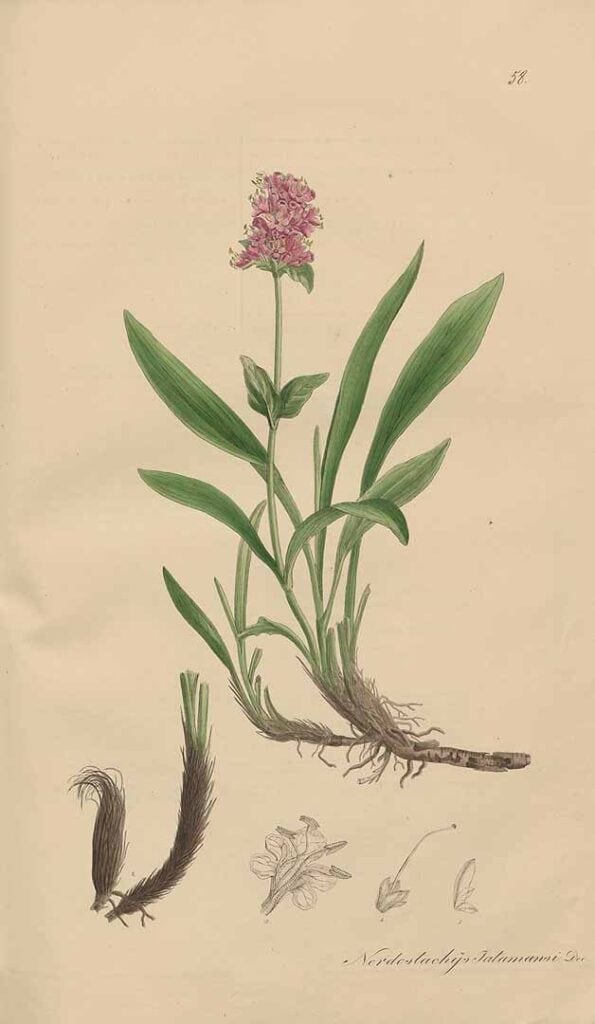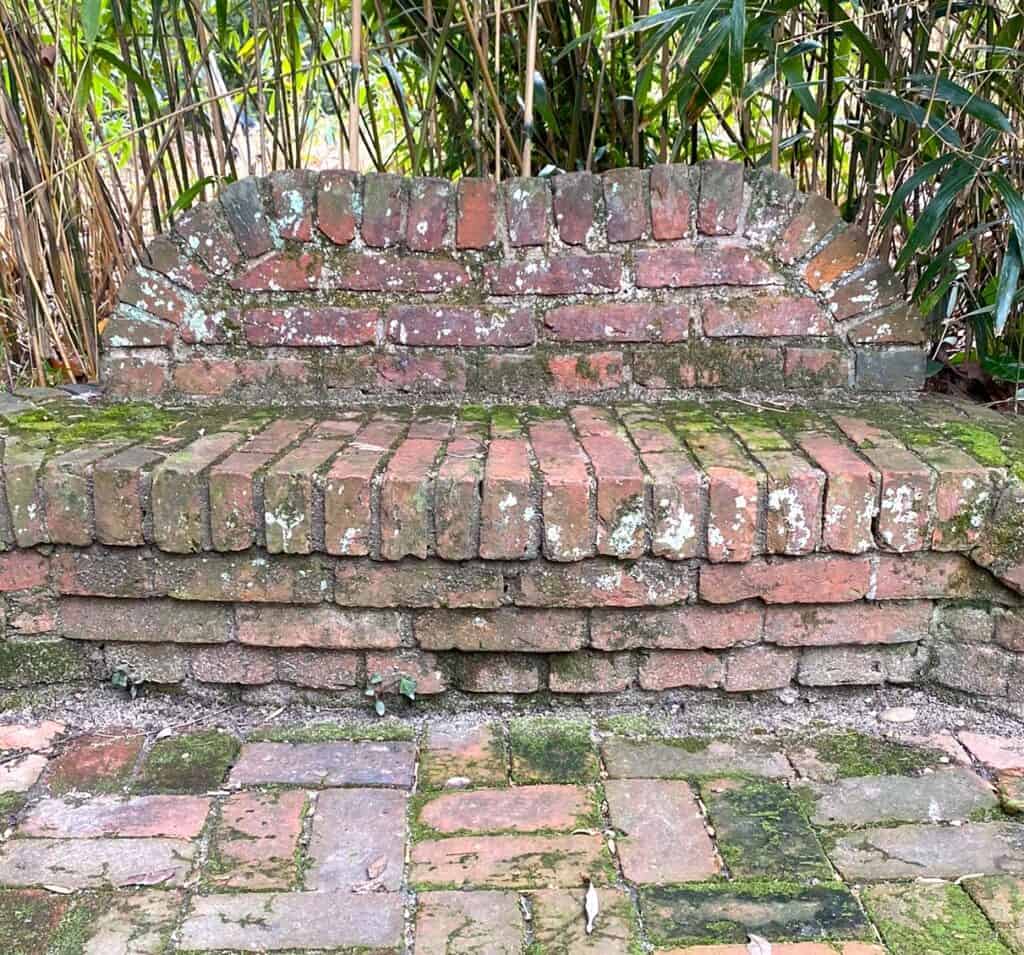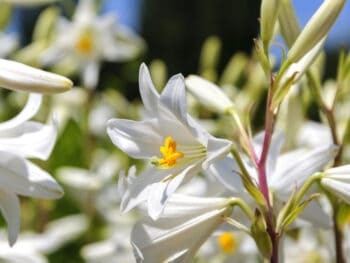We are closing in on the final days of Lent, drawing close to Jesus as He entered into His last week. Let’s enter in, too, by savoring a plant detail, which connects profound moments of Scripture, revealing a rich backstory to His passion. In the Song of Songs garden, the beloved calls for fragrance everywhere. Her Bridegroom had just named a profusion of spicy aromas—
They grow like an orchard of pomegranate trees and bear the finest fruits. There is no lack of henna and nard, of saffron, calamus, and cinnamon, or incense of every kind. Myrrh and aloes grow there with all the most fragrant perfumes. Song of Songs 4:12-14 GNT
—and her exuberance yearned for the enthralling scents to waft everywhere and fill the air.
Awake, north wind, and come, south wind! Blow on my garden, that its fragrance may spread everywhere. Song of Songs 4:16 NIV
While we have explored much of this plentiful plant list in The Bride’s Garden devotions, let us turn our attention specifically to nard, or spikenard, Nardostachys jatamansi. The description of fragrance everywhere scenting the space brings us to another poignant mention of this ancient potion.
Mary’s Fragrance Encounter with Jesus
Just days before Jesus’ death, Mary poured out spikenard perfume on His feet in reverent regard, and fragrance filled the air.
Then Mary took a pound of fragrant oil—pure and expensive nard—anointed Jesus’ feet, and wiped His feet with her hair. So the house was filled with the fragrance of the oil. John 12:3 HCSB
What a matchless moment to come about in the hubbub of much company at dinner. She took her measure of scented oil, and—resounding the riveted devotion and pure, loving attachment of the Song of Songs bride and Bridegroom—poured out the oil of spikenard on His hallowed feet. Was she prompted by the Holy Spirit to care for Jesus and prepare for His burial (John 12:7) in this provocative way? Her posture was humble but her gesture was bold and extravagant, considering the cost of spikenard, a plant harvested far away near the Himalayan mountains and transported by trade caravans to the Holy Land.

I can’t imagine that she knew her Master would be likewise washing His dear friends’ feet with the same fondness and tender touch at His lingering dinner with them; nor could she fathom that His feet, which had walked patiently beside them for years, would soon be covered in blood, tortured, and mangled as they were nailed to the cross. Ugh. It seems she simply moved in a manner normal to her heart, which was attuned exclusively to her Master.
Mary Was Ready
Mary had this special encounter with Jesus, a pause or rest, like a silent beat of music, as if she heard a personal summons in the singsong of dinner. She brings us back around to Jesus’ story of the ten bridesmaids (Matthew 25:1-13; or see The Bride’s Garden beginning), portraying a wise one having a personal supply of oil, ready when opportunity awakened.
The wise bridesmaids took their lamps and more oil in jars. Because the bridegroom was late, they became sleepy and went to sleep. At midnight someone cried out, ‘The bridegroom is coming! Come and meet him!’ Then all the bridesmaids woke up and got their lamps ready…So while the five foolish bridesmaids went to buy oil, the bridegroom came. The bridesmaids who were ready went in with the bridegroom to the wedding feast. Matthew 25:4-7, 10 NCV
Mary was ready! She must have cherished this memory, her lavish engagement with her Master, a special treasure to have and to hold as she muddled through the painful, confusing days embroiled in Jesus’ death. Truly, she holds it to this day, in the gift and mystery that is eternal life. Her encounter was far more valuable than the costly nard perfume, and she showed herself in possession of God’s wisdom.
Her outpouring of aroma marked a change in the atmosphere, trumpeting like lilies the scented sounding of a new way of life ahead, of intimate knowledge of the Lord, filled with His Spirit. Pause with me in God’s Words and take them in like fragrance everywhere.
And the Spirit of the Lord shall rest upon Him—the Spirit of wisdom and understanding, the Spirit of counsel and might, the Spirit of knowledge and of the fear of the Lord Isaiah 11:2 KJV
I will pour out my Spirit on your offspring, and my blessing on your descendants. Isaiah 44:3 NIV
I will give you a new heart and put a new spirit in you; I will remove from you your heart of stone and give you a heart of flesh. Ezekiel 11:19, 36:26 NIV
From this moment on, everything in this world is about to change…John 12:31 TPT
But the one who joins himself to the Lord is one spirit with Him. 1 Corinthians 6:17 NASB
Have you forgotten that your body is now the sacred temple of the Spirit of Holiness, who lives in you? You don’t’ belong to yourself any longer, for the gift of God, the Holy Spirit, lives inside your sanctuary. You were God’s expensive purchase, paid for with tears of blood 1 Corinthians 6:19-20 TPT
Always pursue doing what is beautiful to one another and to all unbelievers. 1 Thessalonians 5:15 TPT
Who in your community is understanding and wise? Let his example, which is marked by wisdom and gentleness, blaze a trail for others. James 3:13 VOICE

Fragrance Everywhere in The Bride’s Garden

Nard, or spikenard, belongs to Caprifoliaceae, the honeysuckle family (for plant geeks—formerly the valerian family; per 2009 APG III, Valerianoideae is a sub-family of the honeysuckles). This aromatic novelty is a modest perennial growing from coir-like rhizomes. The scent of spikenard comes from oil extracted from its rhizome-roots and the first few inches of emerging stems, though the plant sends up petite, rose-purple blossom bouquets to delight in a diminutive way.
Spikenard is at home in an alpine landscape, best grown in cool summers with dappled sunlight for this forest plant. Loamy soil preferred. The flowers are said to have gentle fragrance, growing several clusters to a stem, about 24 inches tall, blooming in summertime. Nard continues in its exclusive quality from Scripture, rarely available commercially to home gardeners.
Visit Spikenard Care & Growing Tips at Plantiago for more information
Spikenard Substitutes
What can we plant as a stand-in, to represent the intimate magnificence of bride and Bridegroom and sound the call to Mary’s readiness? While some prefer to keep their Biblical gardens pure with only Scripturally accurate plantings, I use a little poetic license where climate calls for it. After all, God created all of the plants, all praises to God! Even the work of cultivars begins with God’s creations. The following flowers share varying similarities to spikenard, some profuse with fragrance everywhere filling the air, and some infusing the garden instead with gentle intrigue, causing us to draw closer to take in their scents.

Valerian, Valeriana officinalis, is a close cousin to nard, with a similar form and horticulture, naturalized across America and Canada. Abundant in alpine meadows, its fragrant, white, or light pinkish flowers bless summers with blooms. Like nard, its rhizomes are prized, yielding medicinal valerian. Invasive in some northern states. Grow this herb from seeds at Johnny’s Seeds. Photo from Johnny’s Seeds.

American Spikenard, Aralia racemosa, is a shade-loving shrub I discovered last summer in a private garden near Minneapolis. This plant shares no commonalities with Biblical spikenard in form or habit, with no remarkable fragrance, either! But in name alone, and with bridal-like white flower sprays blooming in summer before turning to deep purple, non-edible berries, you might enjoy this easy-to-grow American native in your Bride’s Garden.

Tuberose, Polianthes tuberosa or Agave amica, is a delightfully fragrant flower grown from tubers, planted in spring to bloom in summer. With good drainage, plants should be perennial in zones 7-10, or dig tubers up to store for winter. Flower spikes reach 2 – 4 feet, with multiple buds on each stem. This flower spreads fragrance everywhere, in the garden or cut in vases so the house will be filled! This pretty double tuberose ‘The Pearl’ is available at Spring Hill Nursery. Photo from Spring Hill Nursery.

Cornflower ‘Sweet Sultan The Bride,’ Centaurea moschata cultivar, caught my eye from National Garden Bureau’s new plants for 2024. This pure white annual seems a natural for The Bride’s Garden, and its tufted, showy blooms have a welcoming scent enjoyed in the garden or in vases, another bloom to help the house be filled with fragrance everywhere. Flowers grow 24 to 36 inches, similar to nard plants. Photo from National Garden Bureau

Gladiolus ‘Muriela,’ Callianthus variety, is a fragrant gladiolus originally from Africa. This perennial will grow nicely next to calamus in your Bride’s Garden, enjoying full sun and a reed-like form. Dr. Lytton Musselman, dedicated Biblical botanist, likes gladiolus for the “rose of Sharon (Song of Songs 2:1),” so ‘Muriela’ could stand in for two Scriptures describing the Song of Songs scenery. Grow them from corms available at Brent & Becky’s Bulbs. Photo from Brent & Becky’s
Closing Prayer
Dearest Lord, thank You for surrounding me in Your Words and delighting me with delicious scents. Thank You that Your Spirit is here to change the atmosphere with Your rich, lavish love. Thank You for sending trailblazers like Mary, who shows us what it is to be ready for an encounter with you, in quiet garden moments or spicy community dinners. Fragrance everywhere is a beautiful metaphor to picture your love and wisdom flowing out of your people via exclusive encounters, moved by Your Spirit. You are pure, and holy, O Lord, and I am glad to know You. Amen.
Move you heart closer and closer to God and he will come even closer to you. James 4:8 TPT


The Bride’s Garden is a 7-week series for the Lenten Season, focusing our thoughts and meditations on God’s Words of garden matrimony. Especially, the Scriptures swooning with flowering, fruiting plants contained in Song of Songs. While God hints throughout the Bible of His Bridegroom-like devotion to His people, He goes all-out with lavish botanicals in King Solomon’s bridal songbook, describing scents and fruits and enthralling garden views, giving us things to have and to hold as we cultivate a deeper longing for Him.

Naturally, Song of Songs has been a joy to dig into for years in the Devotions Blog at Garden in Delight, with a wide range of enticing plants to spice up a Biblical Garden. Refer to these articles for additional ideas for your Bride’s Garden: Verdant (maidenhair fern, Songs 1:16); A Father’s Tree, The Lollipop® Crabapple Story (Songs 2:3); Strengthen Me with Raisins, Refresh Me with Apples (Songs 2:5); Under your Own Vine and Fig Tree (Songs 2:13); Cultivating Calamus (Songs 4:14); God’s Focus in Saffron Crocus (Songs 4:14); Eaglewood in God’s Word (aloes, Songs 4:14); Pistachio Cookies or A Lenten Look at Trees: Almond (nut trees, Songs 6:11); Blue Wheat (Songs 7:2); Fresh Kale & Date Salad (Songs 7:8). Additionally, Song of Songs includes 5 of the 7 Species, read more at The 7 Species: A Garden-to-Table Guide

Do you love connecting God’s Word to your gardening work and the trees and plants around you? You will love my new book, My Father is the Gardener, Devotions in Botany and Gardening of the Bible, order at this link.

Read more devotions on the Song of Songs gardens in God’s Word for Gardeners Bible in the Garden Tour section on En Gedi, beginning on page a-16
Photo Credits: Cover image – Photo 97081533 © Dachux21 | Dreamstime.com Beautiful valerian flowers blossoming in a summer meadow. A vibrant scenery (in Europe); botanical illustration of Nardostachys jatamansi by T.F.L. Nees von Esenbeck and M.F. Wijhe (Weyhe), Plantae medicinales, Supplement (1828-1833) Plate 58. From www.plantillustrations.org; rhizomes of spikenard, also called muskroot Photo 16618283 | Nardostachys Jatamansi © Ziprashantzi | Dreamstime.com; “spikenard substitutes” plant photos listed above; all other photos by Shelley S. Cramm
GNT denotes Scripture quotations from the Good News Translation® (Today’s English Version, Second Edition) Copyright © 1992 American Bible Society. All rights reserved.
HCSB denotes Scripture quotations taken from the Holman Christian Standard Bible®, Copyright © 1999, 2000, 2002, 2003, 2009 by Holman Bible Publishers. Used by permission. Holman Christian Standard Bible®, Holman CSB®, and HCSB® are federally registered trademarks of Holman Bible Publishers.
KJV denotes Scriptures taken from The Holy Bible, King James Version published in 1611, authorized by King James I of England, which is public domain in the United States.
NASB denotes Scripture quotations taken from the NEW AMERICAN STANDARD BIBLE®, Copyright © 1960,1962,1963,1968,1971,1972,1973,1975,1977,1995 by The Lockman Foundation. Used by permission.
NCV denotes Scripture quotations taken from the New Century Version®. Copyright © 2005 by Thomas Nelson. Used by permission. All rights reserved.
NIV denotes Scripture quotations taken from the Holy Bible, New International Version®, NIV®. Copyright © 1973, 1978, 1984, 2011 by Biblica, Inc.® Used by permission of Zondervan. All rights reserved worldwide. www.zondervan.com The “NIV” and “New International Version” are trademarks registered in the United States Patent and Trademark Office by Biblica, Inc.®
TPT denotes Scripture quotations taken from The Passion Translation®. Copyright © 2017, 2018, 2020 by Passion & Fire Ministries, Inc. Used by permission. All rights reserved. ThePassionTranslation.com
VOICE denotes Scripture quotations taken from The Voice™. Copyright © 2012 by Ecclesia Bible Society. Used by permission. All rights reserved.













